Green Logistics: Strategies, Implications, and Technologies Report
VerifiedAdded on 2020/12/09
|7
|1710
|473
Report
AI Summary
This report delves into the realm of green logistics, examining its core concepts within the supply chain and its transformative impact on traditional supply chain management practices. It explores the implications of a growing global population on environmental sustainability, highlighting the increasing demand for resources and the need for innovative solutions. The report further analyzes the role of technology and government policies in managing pollution and climate control, providing examples of biofuels and the Climate Change Act. It then presents five key strategies for companies to pursue green logistics and transportation, including carbon footprint measurement, environmentally friendly packaging, sustainable warehousing, transportation audits, and the Just-In-Time approach. The report underscores the importance of these strategies in ensuring environmental sustainability and protecting the environment.

GREEN LOGISTICS
Paraphrase This Document
Need a fresh take? Get an instant paraphrase of this document with our AI Paraphraser
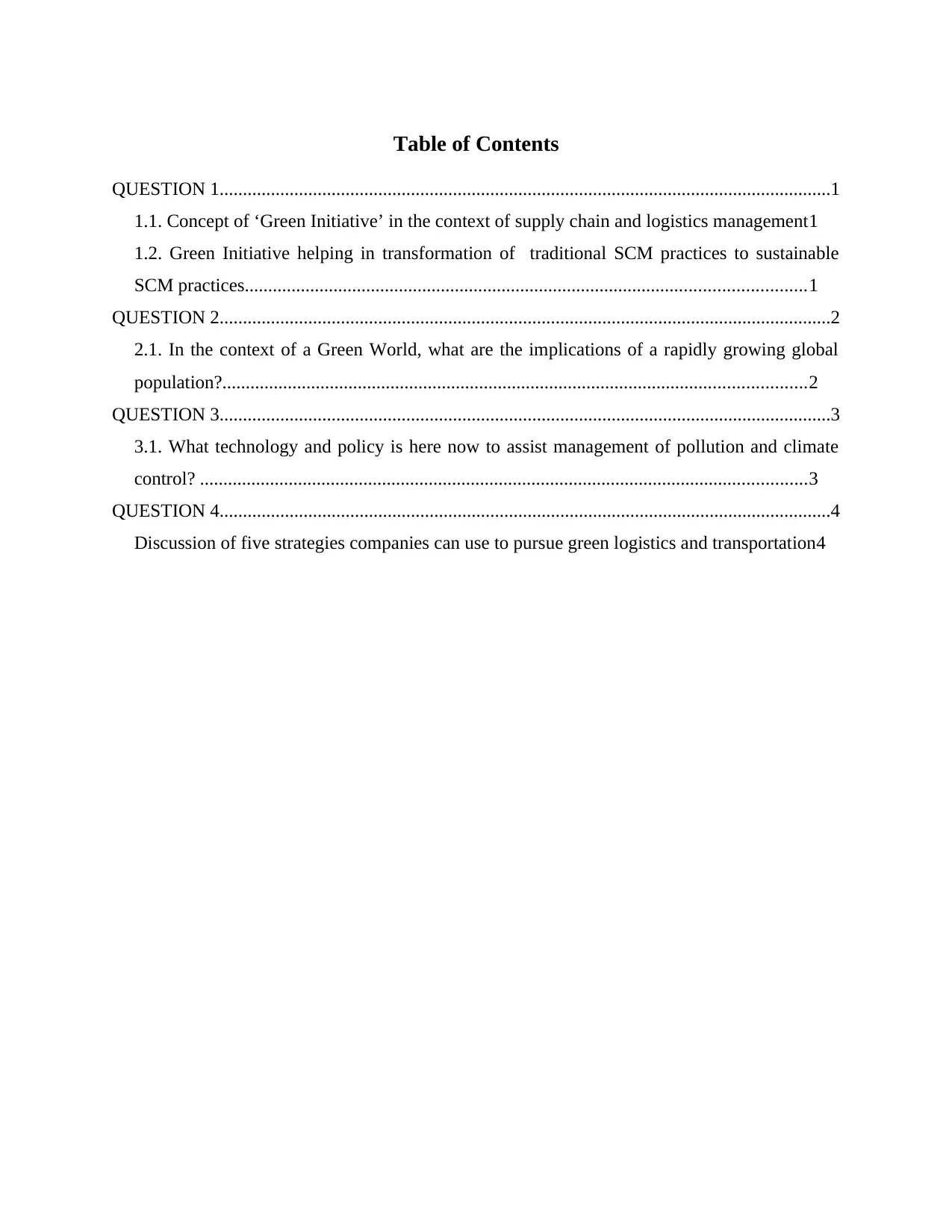
Table of Contents
QUESTION 1...................................................................................................................................1
1.1. Concept of ‘Green Initiative’ in the context of supply chain and logistics management1
1.2. Green Initiative helping in transformation of traditional SCM practices to sustainable
SCM practices........................................................................................................................1
QUESTION 2...................................................................................................................................2
2.1. In the context of a Green World, what are the implications of a rapidly growing global
population?.............................................................................................................................2
QUESTION 3...................................................................................................................................3
3.1. What technology and policy is here now to assist management of pollution and climate
control? ..................................................................................................................................3
QUESTION 4...................................................................................................................................4
Discussion of five strategies companies can use to pursue green logistics and transportation4
QUESTION 1...................................................................................................................................1
1.1. Concept of ‘Green Initiative’ in the context of supply chain and logistics management1
1.2. Green Initiative helping in transformation of traditional SCM practices to sustainable
SCM practices........................................................................................................................1
QUESTION 2...................................................................................................................................2
2.1. In the context of a Green World, what are the implications of a rapidly growing global
population?.............................................................................................................................2
QUESTION 3...................................................................................................................................3
3.1. What technology and policy is here now to assist management of pollution and climate
control? ..................................................................................................................................3
QUESTION 4...................................................................................................................................4
Discussion of five strategies companies can use to pursue green logistics and transportation4
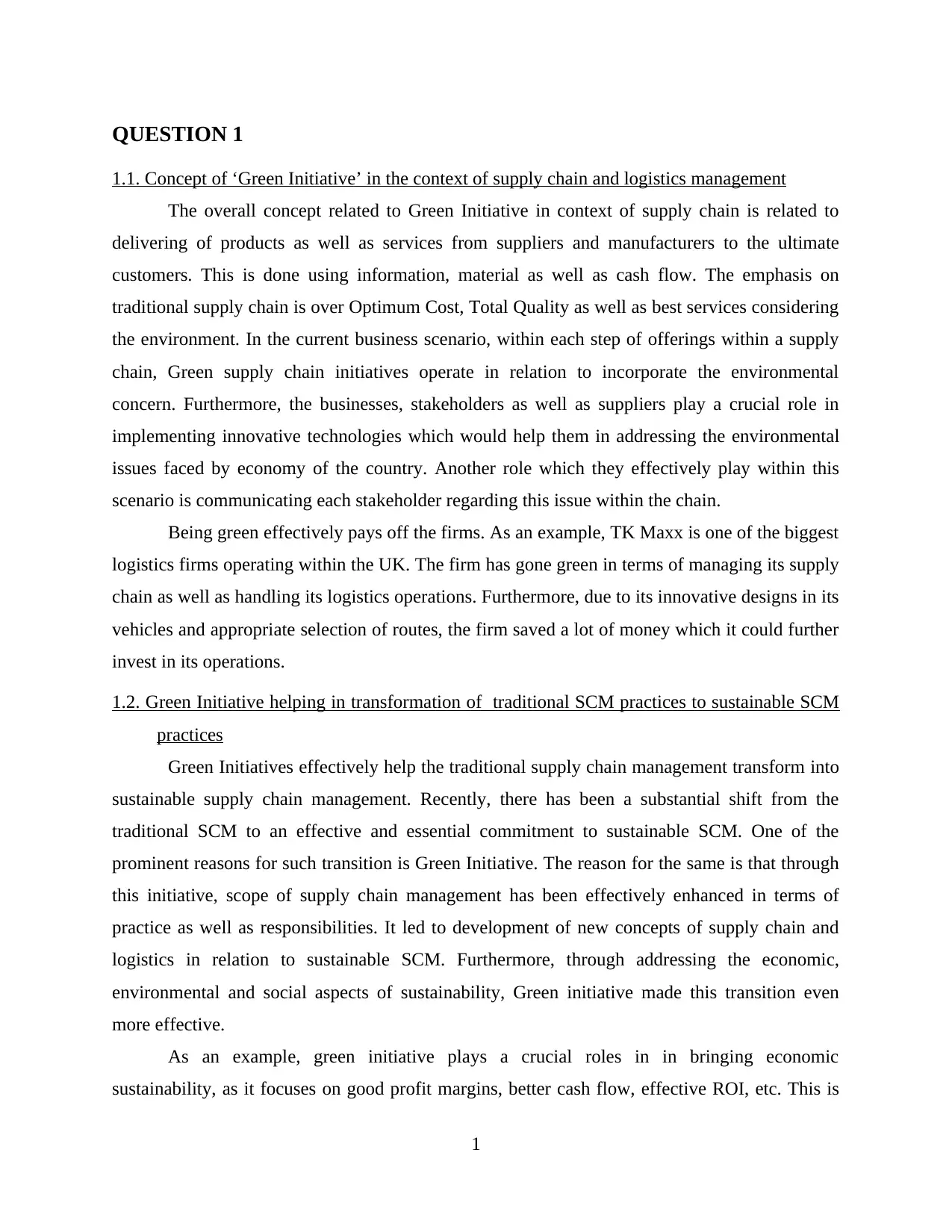
QUESTION 1
1.1. Concept of ‘Green Initiative’ in the context of supply chain and logistics management
The overall concept related to Green Initiative in context of supply chain is related to
delivering of products as well as services from suppliers and manufacturers to the ultimate
customers. This is done using information, material as well as cash flow. The emphasis on
traditional supply chain is over Optimum Cost, Total Quality as well as best services considering
the environment. In the current business scenario, within each step of offerings within a supply
chain, Green supply chain initiatives operate in relation to incorporate the environmental
concern. Furthermore, the businesses, stakeholders as well as suppliers play a crucial role in
implementing innovative technologies which would help them in addressing the environmental
issues faced by economy of the country. Another role which they effectively play within this
scenario is communicating each stakeholder regarding this issue within the chain.
Being green effectively pays off the firms. As an example, TK Maxx is one of the biggest
logistics firms operating within the UK. The firm has gone green in terms of managing its supply
chain as well as handling its logistics operations. Furthermore, due to its innovative designs in its
vehicles and appropriate selection of routes, the firm saved a lot of money which it could further
invest in its operations.
1.2. Green Initiative helping in transformation of traditional SCM practices to sustainable SCM
practices
Green Initiatives effectively help the traditional supply chain management transform into
sustainable supply chain management. Recently, there has been a substantial shift from the
traditional SCM to an effective and essential commitment to sustainable SCM. One of the
prominent reasons for such transition is Green Initiative. The reason for the same is that through
this initiative, scope of supply chain management has been effectively enhanced in terms of
practice as well as responsibilities. It led to development of new concepts of supply chain and
logistics in relation to sustainable SCM. Furthermore, through addressing the economic,
environmental and social aspects of sustainability, Green initiative made this transition even
more effective.
As an example, green initiative plays a crucial roles in in bringing economic
sustainability, as it focuses on good profit margins, better cash flow, effective ROI, etc. This is
1
1.1. Concept of ‘Green Initiative’ in the context of supply chain and logistics management
The overall concept related to Green Initiative in context of supply chain is related to
delivering of products as well as services from suppliers and manufacturers to the ultimate
customers. This is done using information, material as well as cash flow. The emphasis on
traditional supply chain is over Optimum Cost, Total Quality as well as best services considering
the environment. In the current business scenario, within each step of offerings within a supply
chain, Green supply chain initiatives operate in relation to incorporate the environmental
concern. Furthermore, the businesses, stakeholders as well as suppliers play a crucial role in
implementing innovative technologies which would help them in addressing the environmental
issues faced by economy of the country. Another role which they effectively play within this
scenario is communicating each stakeholder regarding this issue within the chain.
Being green effectively pays off the firms. As an example, TK Maxx is one of the biggest
logistics firms operating within the UK. The firm has gone green in terms of managing its supply
chain as well as handling its logistics operations. Furthermore, due to its innovative designs in its
vehicles and appropriate selection of routes, the firm saved a lot of money which it could further
invest in its operations.
1.2. Green Initiative helping in transformation of traditional SCM practices to sustainable SCM
practices
Green Initiatives effectively help the traditional supply chain management transform into
sustainable supply chain management. Recently, there has been a substantial shift from the
traditional SCM to an effective and essential commitment to sustainable SCM. One of the
prominent reasons for such transition is Green Initiative. The reason for the same is that through
this initiative, scope of supply chain management has been effectively enhanced in terms of
practice as well as responsibilities. It led to development of new concepts of supply chain and
logistics in relation to sustainable SCM. Furthermore, through addressing the economic,
environmental and social aspects of sustainability, Green initiative made this transition even
more effective.
As an example, green initiative plays a crucial roles in in bringing economic
sustainability, as it focuses on good profit margins, better cash flow, effective ROI, etc. This is
1
⊘ This is a preview!⊘
Do you want full access?
Subscribe today to unlock all pages.

Trusted by 1+ million students worldwide
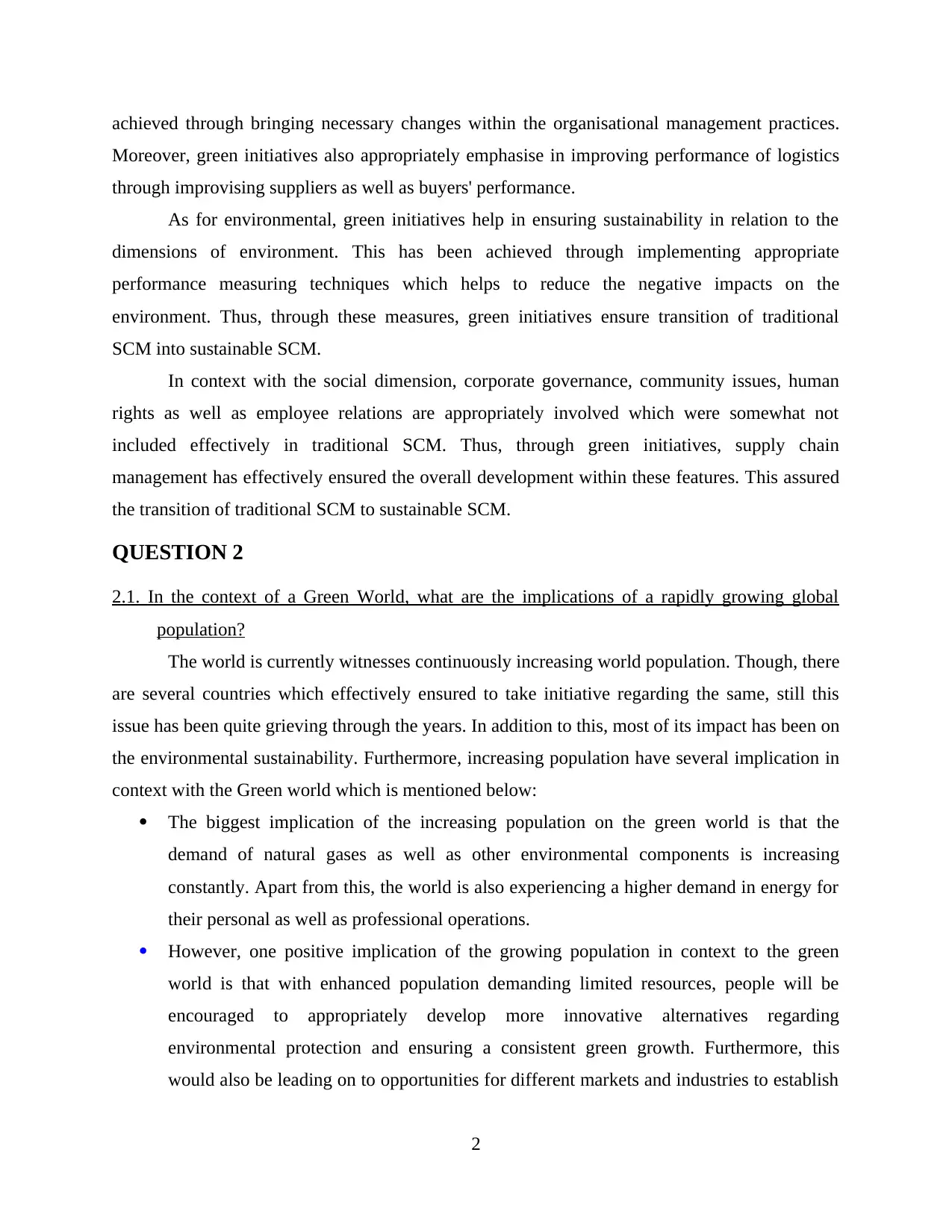
achieved through bringing necessary changes within the organisational management practices.
Moreover, green initiatives also appropriately emphasise in improving performance of logistics
through improvising suppliers as well as buyers' performance.
As for environmental, green initiatives help in ensuring sustainability in relation to the
dimensions of environment. This has been achieved through implementing appropriate
performance measuring techniques which helps to reduce the negative impacts on the
environment. Thus, through these measures, green initiatives ensure transition of traditional
SCM into sustainable SCM.
In context with the social dimension, corporate governance, community issues, human
rights as well as employee relations are appropriately involved which were somewhat not
included effectively in traditional SCM. Thus, through green initiatives, supply chain
management has effectively ensured the overall development within these features. This assured
the transition of traditional SCM to sustainable SCM.
QUESTION 2
2.1. In the context of a Green World, what are the implications of a rapidly growing global
population?
The world is currently witnesses continuously increasing world population. Though, there
are several countries which effectively ensured to take initiative regarding the same, still this
issue has been quite grieving through the years. In addition to this, most of its impact has been on
the environmental sustainability. Furthermore, increasing population have several implication in
context with the Green world which is mentioned below:
The biggest implication of the increasing population on the green world is that the
demand of natural gases as well as other environmental components is increasing
constantly. Apart from this, the world is also experiencing a higher demand in energy for
their personal as well as professional operations.
However, one positive implication of the growing population in context to the green
world is that with enhanced population demanding limited resources, people will be
encouraged to appropriately develop more innovative alternatives regarding
environmental protection and ensuring a consistent green growth. Furthermore, this
would also be leading on to opportunities for different markets and industries to establish
2
Moreover, green initiatives also appropriately emphasise in improving performance of logistics
through improvising suppliers as well as buyers' performance.
As for environmental, green initiatives help in ensuring sustainability in relation to the
dimensions of environment. This has been achieved through implementing appropriate
performance measuring techniques which helps to reduce the negative impacts on the
environment. Thus, through these measures, green initiatives ensure transition of traditional
SCM into sustainable SCM.
In context with the social dimension, corporate governance, community issues, human
rights as well as employee relations are appropriately involved which were somewhat not
included effectively in traditional SCM. Thus, through green initiatives, supply chain
management has effectively ensured the overall development within these features. This assured
the transition of traditional SCM to sustainable SCM.
QUESTION 2
2.1. In the context of a Green World, what are the implications of a rapidly growing global
population?
The world is currently witnesses continuously increasing world population. Though, there
are several countries which effectively ensured to take initiative regarding the same, still this
issue has been quite grieving through the years. In addition to this, most of its impact has been on
the environmental sustainability. Furthermore, increasing population have several implication in
context with the Green world which is mentioned below:
The biggest implication of the increasing population on the green world is that the
demand of natural gases as well as other environmental components is increasing
constantly. Apart from this, the world is also experiencing a higher demand in energy for
their personal as well as professional operations.
However, one positive implication of the growing population in context to the green
world is that with enhanced population demanding limited resources, people will be
encouraged to appropriately develop more innovative alternatives regarding
environmental protection and ensuring a consistent green growth. Furthermore, this
would also be leading on to opportunities for different markets and industries to establish
2
Paraphrase This Document
Need a fresh take? Get an instant paraphrase of this document with our AI Paraphraser
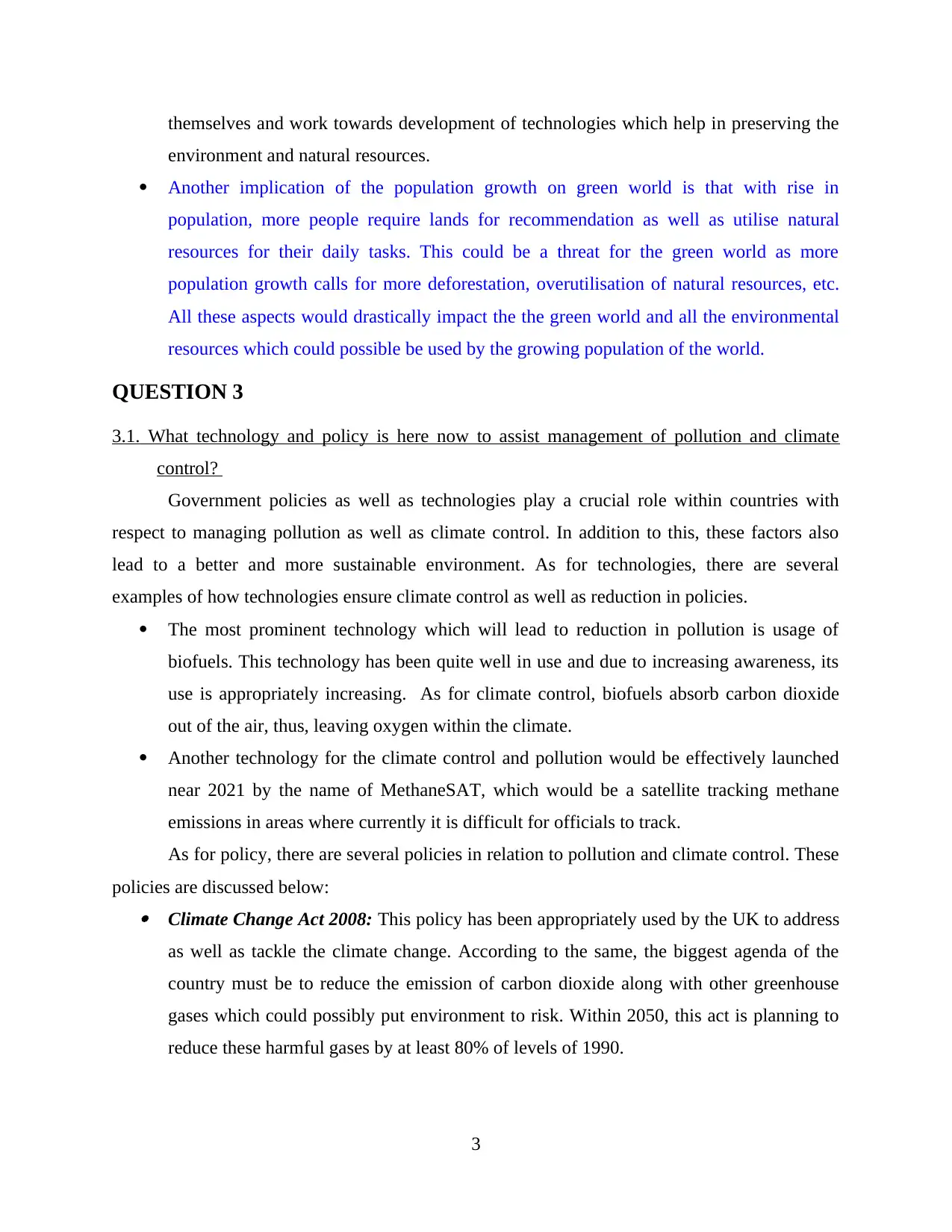
themselves and work towards development of technologies which help in preserving the
environment and natural resources.
Another implication of the population growth on green world is that with rise in
population, more people require lands for recommendation as well as utilise natural
resources for their daily tasks. This could be a threat for the green world as more
population growth calls for more deforestation, overutilisation of natural resources, etc.
All these aspects would drastically impact the the green world and all the environmental
resources which could possible be used by the growing population of the world.
QUESTION 3
3.1. What technology and policy is here now to assist management of pollution and climate
control?
Government policies as well as technologies play a crucial role within countries with
respect to managing pollution as well as climate control. In addition to this, these factors also
lead to a better and more sustainable environment. As for technologies, there are several
examples of how technologies ensure climate control as well as reduction in policies.
The most prominent technology which will lead to reduction in pollution is usage of
biofuels. This technology has been quite well in use and due to increasing awareness, its
use is appropriately increasing. As for climate control, biofuels absorb carbon dioxide
out of the air, thus, leaving oxygen within the climate.
Another technology for the climate control and pollution would be effectively launched
near 2021 by the name of MethaneSAT, which would be a satellite tracking methane
emissions in areas where currently it is difficult for officials to track.
As for policy, there are several policies in relation to pollution and climate control. These
policies are discussed below: Climate Change Act 2008: This policy has been appropriately used by the UK to address
as well as tackle the climate change. According to the same, the biggest agenda of the
country must be to reduce the emission of carbon dioxide along with other greenhouse
gases which could possibly put environment to risk. Within 2050, this act is planning to
reduce these harmful gases by at least 80% of levels of 1990.
3
environment and natural resources.
Another implication of the population growth on green world is that with rise in
population, more people require lands for recommendation as well as utilise natural
resources for their daily tasks. This could be a threat for the green world as more
population growth calls for more deforestation, overutilisation of natural resources, etc.
All these aspects would drastically impact the the green world and all the environmental
resources which could possible be used by the growing population of the world.
QUESTION 3
3.1. What technology and policy is here now to assist management of pollution and climate
control?
Government policies as well as technologies play a crucial role within countries with
respect to managing pollution as well as climate control. In addition to this, these factors also
lead to a better and more sustainable environment. As for technologies, there are several
examples of how technologies ensure climate control as well as reduction in policies.
The most prominent technology which will lead to reduction in pollution is usage of
biofuels. This technology has been quite well in use and due to increasing awareness, its
use is appropriately increasing. As for climate control, biofuels absorb carbon dioxide
out of the air, thus, leaving oxygen within the climate.
Another technology for the climate control and pollution would be effectively launched
near 2021 by the name of MethaneSAT, which would be a satellite tracking methane
emissions in areas where currently it is difficult for officials to track.
As for policy, there are several policies in relation to pollution and climate control. These
policies are discussed below: Climate Change Act 2008: This policy has been appropriately used by the UK to address
as well as tackle the climate change. According to the same, the biggest agenda of the
country must be to reduce the emission of carbon dioxide along with other greenhouse
gases which could possibly put environment to risk. Within 2050, this act is planning to
reduce these harmful gases by at least 80% of levels of 1990.
3
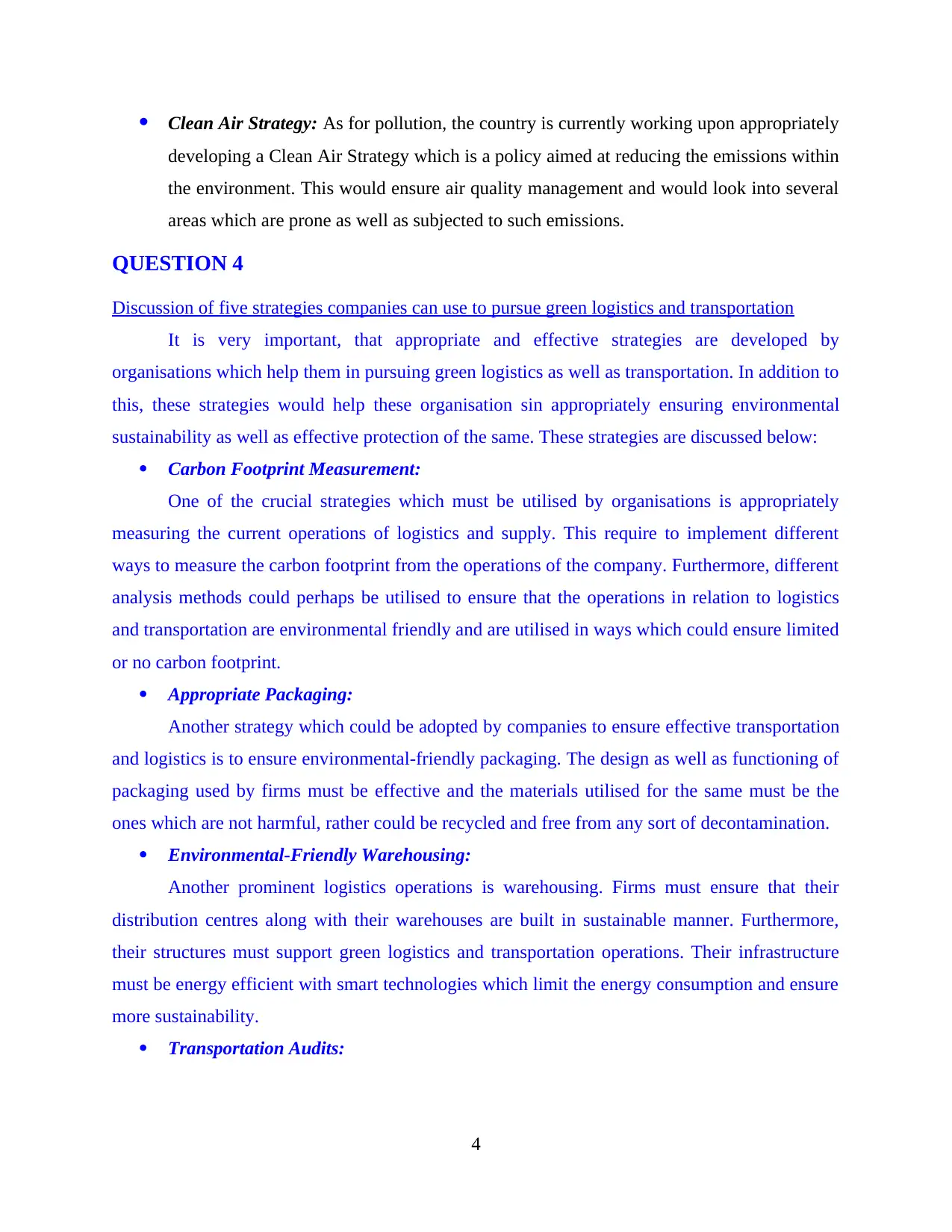
Clean Air Strategy: As for pollution, the country is currently working upon appropriately
developing a Clean Air Strategy which is a policy aimed at reducing the emissions within
the environment. This would ensure air quality management and would look into several
areas which are prone as well as subjected to such emissions.
QUESTION 4
Discussion of five strategies companies can use to pursue green logistics and transportation
It is very important, that appropriate and effective strategies are developed by
organisations which help them in pursuing green logistics as well as transportation. In addition to
this, these strategies would help these organisation sin appropriately ensuring environmental
sustainability as well as effective protection of the same. These strategies are discussed below:
Carbon Footprint Measurement:
One of the crucial strategies which must be utilised by organisations is appropriately
measuring the current operations of logistics and supply. This require to implement different
ways to measure the carbon footprint from the operations of the company. Furthermore, different
analysis methods could perhaps be utilised to ensure that the operations in relation to logistics
and transportation are environmental friendly and are utilised in ways which could ensure limited
or no carbon footprint.
Appropriate Packaging:
Another strategy which could be adopted by companies to ensure effective transportation
and logistics is to ensure environmental-friendly packaging. The design as well as functioning of
packaging used by firms must be effective and the materials utilised for the same must be the
ones which are not harmful, rather could be recycled and free from any sort of decontamination.
Environmental-Friendly Warehousing:
Another prominent logistics operations is warehousing. Firms must ensure that their
distribution centres along with their warehouses are built in sustainable manner. Furthermore,
their structures must support green logistics and transportation operations. Their infrastructure
must be energy efficient with smart technologies which limit the energy consumption and ensure
more sustainability.
Transportation Audits:
4
developing a Clean Air Strategy which is a policy aimed at reducing the emissions within
the environment. This would ensure air quality management and would look into several
areas which are prone as well as subjected to such emissions.
QUESTION 4
Discussion of five strategies companies can use to pursue green logistics and transportation
It is very important, that appropriate and effective strategies are developed by
organisations which help them in pursuing green logistics as well as transportation. In addition to
this, these strategies would help these organisation sin appropriately ensuring environmental
sustainability as well as effective protection of the same. These strategies are discussed below:
Carbon Footprint Measurement:
One of the crucial strategies which must be utilised by organisations is appropriately
measuring the current operations of logistics and supply. This require to implement different
ways to measure the carbon footprint from the operations of the company. Furthermore, different
analysis methods could perhaps be utilised to ensure that the operations in relation to logistics
and transportation are environmental friendly and are utilised in ways which could ensure limited
or no carbon footprint.
Appropriate Packaging:
Another strategy which could be adopted by companies to ensure effective transportation
and logistics is to ensure environmental-friendly packaging. The design as well as functioning of
packaging used by firms must be effective and the materials utilised for the same must be the
ones which are not harmful, rather could be recycled and free from any sort of decontamination.
Environmental-Friendly Warehousing:
Another prominent logistics operations is warehousing. Firms must ensure that their
distribution centres along with their warehouses are built in sustainable manner. Furthermore,
their structures must support green logistics and transportation operations. Their infrastructure
must be energy efficient with smart technologies which limit the energy consumption and ensure
more sustainability.
Transportation Audits:
4
⊘ This is a preview!⊘
Do you want full access?
Subscribe today to unlock all pages.

Trusted by 1+ million students worldwide
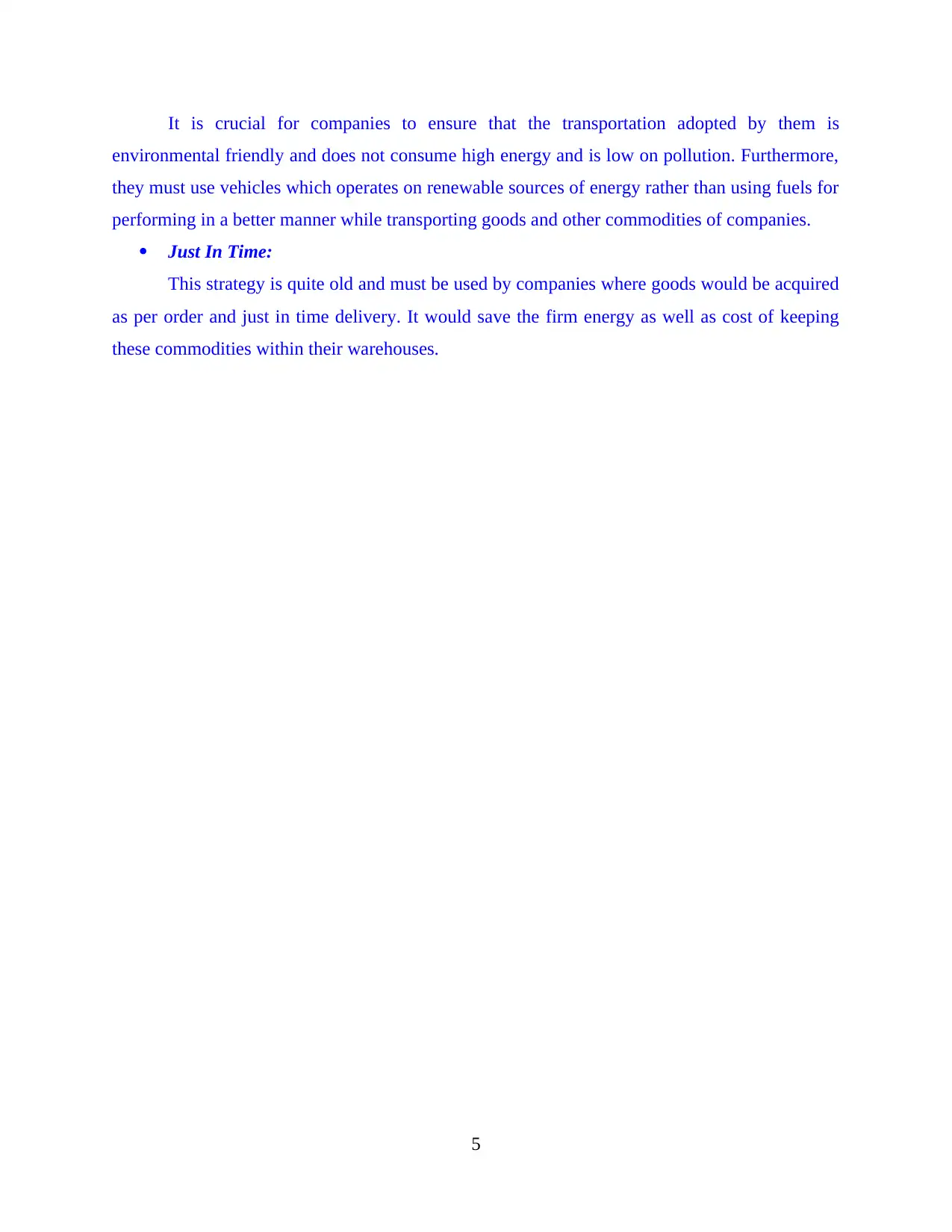
It is crucial for companies to ensure that the transportation adopted by them is
environmental friendly and does not consume high energy and is low on pollution. Furthermore,
they must use vehicles which operates on renewable sources of energy rather than using fuels for
performing in a better manner while transporting goods and other commodities of companies.
Just In Time:
This strategy is quite old and must be used by companies where goods would be acquired
as per order and just in time delivery. It would save the firm energy as well as cost of keeping
these commodities within their warehouses.
5
environmental friendly and does not consume high energy and is low on pollution. Furthermore,
they must use vehicles which operates on renewable sources of energy rather than using fuels for
performing in a better manner while transporting goods and other commodities of companies.
Just In Time:
This strategy is quite old and must be used by companies where goods would be acquired
as per order and just in time delivery. It would save the firm energy as well as cost of keeping
these commodities within their warehouses.
5
1 out of 7
Related Documents
Your All-in-One AI-Powered Toolkit for Academic Success.
+13062052269
info@desklib.com
Available 24*7 on WhatsApp / Email
![[object Object]](/_next/static/media/star-bottom.7253800d.svg)
Unlock your academic potential
Copyright © 2020–2025 A2Z Services. All Rights Reserved. Developed and managed by ZUCOL.




